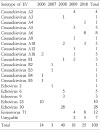Abstract
Purpose
This study was performed to investigate the epidemiology of enterovirus (EV) infections in children at a secondary hospital during recent 5 years.
Methods
We collected the cerebrospinal fluid, stool and throat swab samples from the pediatric patients with suspected EV infections in KEPCO Medical Center, Seoul, Korea from July 2006 to September 2010. EV detection and genotype identification were performed by RT-PCR at Korea Centers for Disease Control and Prevention.
Results
A total of 386 samples were collected from 277 patients during study period. Ninety-eight patients (35.4%) were diagnosed with EV infections. The RT-PCR positive rate was the highest in throat swab samples (48.3%). The median age of patient was 4.7 years (range, 0.1-12.5 years). Aseptic meningitis (50, 51.0%) was the most common clinical manifestation; herpangina (22, 22.4%) and hand-foot-mouth disease (18, 18.4%). One hundred EVs were isolated from 98 patients and 20 genotypes of EV were identified; Echovirus 30 (28 cases, 28%), Enterovirus 71 (12 cases, 12%), Echovirus 25 (10 cases, 10%), Echovirus 9 (9 cases, 9%) and Coxsackievirus A6 (8 cases, 8%). Aseptic meningitis caused by Echovirus 30 was the most common manifestation in 2008. There was no complicated case caused by Enterovirus 71.
Figures and Tables
References
1. Solomon T, Lewthwaite P, Perera D, Cardosa MJ, McMinn P, Ooi MH. Virology, epidemiology, pathogenesis, and control of enterovirus 71. Lancet Infect Dis. 2010; 10:778–790.

2. Ooi MH, Wong SC, Lewthwaite P, Cardosa MJ, Solomon T. Clinical features, diagnosis, and management of enterovirus 71. Lancet Neurol. 2010; 9:1097–1105.

3. Korea Centers for Disease Control and Prevention. National laboratory surveillance for enterovirus. Public Health Weekly Report. 2008. 1:617–621. accessed on 2 Mar 2013. Available at http://www.cdc.go.kr/CDC/info/CdcKrInfo0301.jsp?menuIds=HOME001-MNU0004-MNU0036-MNU0037.
4. Jee Y, Cheon D, Choi W, Ahn J, Kim K, Chung Y, et al. Updates on enterovirus surveillance in Korea. Infect Chemother. 2004; 36:294–303.
5. Kim SJ, Kim JH, Kang JH, Kim DS, Kim KH, Kim KH, et al. Risk factors for neurologic complications of hand, foot and mouth disease in the Republic of Korea, 2009. J Korean Med Sci. 2013; 28:120–127.

6. Korea Centers for Disease Control and Prevention. Laboratory-based surveillance of enterovirus associated diseases in Korea, 2010. Public Health Weekly Report. 2011. 4:935–939. accessed on 2 Mar 2013. Available at http://www.cdc.go.kr/CDC/info/CdcKrInfo0301.jsp?menuIds=HOME001-MNU0004-MNU0036-MNU0037.
7. Ryu WS, Kang B, Hong J, Hwang S, Kim A, Kim J, et al. Enterovirus 71 infection with central nervous system involvement, South Korea. Emerg Infect Dis. 2010; 16:1764–1766.

8. Kim KH. Enterovirus 71 infection: An experience in Korea, 2009. Korean J Pediatr. 2010; 53:616–622.

9. Cho HK, Lee NY, Lee H, Kim HS, Seo JW, Hong YM, et al. Enterovirus 71-associated hand, foot and mouth diseases with neurologic symptoms, a university hospital experience in Korea, 2009. Korean J Pediatr. 2010; 53:639–643.

10. Kim JH, Kim SJ, Cheon DS. Hand-foot-mouth disease related to enterovirus 71. J Korean Med Assoc. 2009; 52:886–894.

11. Park KS, Choi YJ, Park JS. Enterovirus infection in Korean children and anti-enteroviral potential candidate agents. Korean J Pediatr. 2012; 55:359–366.

12. Kim HJ, Kang B, Hwang S, Hong J, Kim K, Cheon DS. Epidemics of viral meningitis caused by echovirus 6 and 30 in Korea in 2008. Virol J. 2012; 9:38.

13. Baek K, Yeo S, Lee B, Park K, Song J, Yu J, et al. Epidemics of enterovirus infection in Chungnam Korea, 2008 and 2009. Virol J. 2011; 8:297.

14. Korea Centers for Disease Control and Prevention. Press release: Hand-foot-and mouth disease and enteroviral diseases are classfied as national notificable infectious diseases. cited on 22 Jun 2009 and modified on 20 Sep 2012. accessed on 2 Mar 2013. Availabe at http://www.cdc.go.kr/CDC/contents/CdcKrContentLink.jsp?fid=21&cid=8983&ctype=1.
15. Ooi MH, Solomon T, Podin Y, Mohan A, Akin W, Yusuf MA, et al. Evaluation of different clinical sample types in diagnosis of human enterovirus 71-associated hand-foot-and-mouth disease. J Clin Microbiol. 2007; 45:1858–1866.

16. Baek K, Park K, Jung E, Chung E, Park J, Choi H, et al. Molecular and epidemiological characterization of enteroviruses isolated in Chungnam, Korea from 2005 to 2006. J Microbiol Biotechnol. 2009; 19:1055–1064.

17. Ryu WS, Kang B, Hong J, Hwang S, Kim J, Cheon DS. Clinical and etiological characteristics of enterovirus 71-related diseases during a recent 2-year period in Korea. J Clin Microbiol. 2010; 48:2490–2494.

18. Choi YJ, Park KS, Baek KA, Jung EH, Nam HS, Kim YB, et al. Molecular characterization of echovirus 30-associated outbreak of aseptic meningitis in Korea in 2008. J Microbiol Biotechnol. 2010; 20:643–649.
19. Cha SH. Recently prevalent infectious diseases among children: meningitis due to enteroviral infection. J Korean Med Assoc. 2008; 51:935–941.

20. Park K, Lee B, Baek K, Cheon D, Yeo S, Park J, et al. Enteroviruses isolated from herpangina and hand-foot-and-mouth disease in Korean children. Virol J. 2012; 9:205.





 PDF
PDF ePub
ePub Citation
Citation Print
Print







 XML Download
XML Download